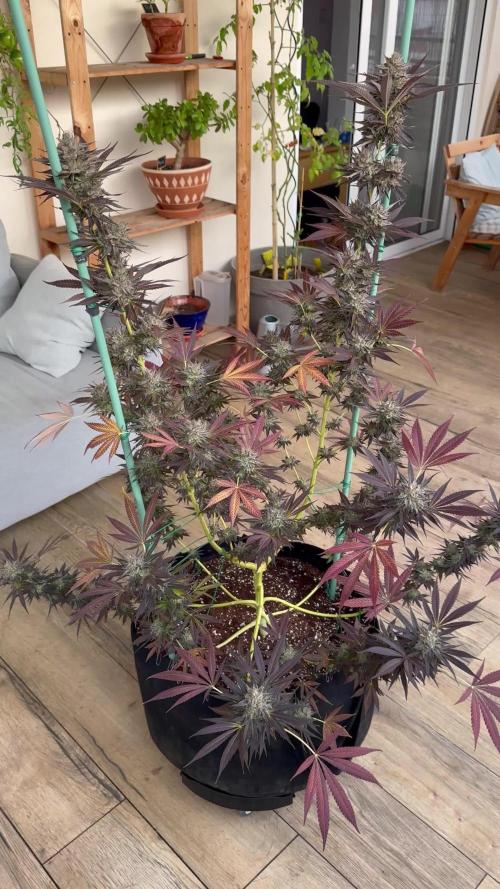The Grow Awards 2026 🏆 



























Likes
Comments
Share


@Ninjabuds
Follow
7 archive seeds are legit super dense tricomb production like nothing I've seen b4. I would NEVER BUY SEEDS FROM ARCHIVESEEDBANK.COM.... they have great genetics but there customer service is garbage. This summer I spent 50 on these 3 seeds and 125 on a 12 pack of reg seeds of a diff strain the reg seeds didn't grow at all and archive never responded they sold me old ass seeds and stole my 125$ I'm happy I already got 32 seeds from the crappy plant of the 3 that I already cut down. I'm letting the last 2 finish up completely
Likes
18
Share


@Mr_Dior21
Follow
This week has been all about shaping the plant. I’ve learned from last that the colas weren’t the same height, because I let the plant do it’s things with just a bit of training. Now I know what to look for so I’m trying my hardest.
I top dressed this week with crab meal, Gaia green all purpose 4-4-4, insect frass, kelp meal, bone meal, azomite, and covered it with a healthy serving of worm castings (about an inch to 2 inches). All of which was sprinkled on all the chopped and dropped leaves/branches. I believe in adding biomass to soil, especially for an indoor growing who is money conscious. Doing that can help save me money going back to the store for more soil.
Likes
75
Share


@ThrashedTV_BakedByGlaze
Follow
Day 49 - 10/28/2020
End of Week 7 and now into Week 8!
The two Liz's are both the bigger plants as the Chocolate Mint OG over-grew the Chem-Bomb Autos from my other diary. Even though both CMOG Auto seeds sprouted later/struggled to start the stress seems to have worked in my favour as it has in the past.
I let them dry out a bit and gave them the final defoliation and LST set up to pull apart the plant and get light to all the secondary sites. Popsicle Sticked the bottoms of the smaller sites that would have taken energy away for larf so each site should be set up for quality over quantity.
These are the two biggest auto plants I have grown so far so I am excited to see how thick the buds get on this one with the addition of the OG Kush Auto genetics compared to my Chocolate Mint OG Photo grow. Seems like the two I popped have really cut out the GrandDaddyPurp influence in the original photo line. No grape smell yet.
Upped the nutes and molasses on the first feed yesterday Oct 28th. Took it well and no burning so after my next plain water ill add a bit more for the end of week 3 of flower.
I didn't get them under the ScrOG in time because i had a partial brake on a Chem-Bomb so you can see in the group pictures i just applied the classic "tie to my pot" LST 😂
Will try to update for Week 8 ASAP, been back to work past few weeks so my free time to update has been cut down unfortunately.
Thanks for checking in! Throw down a like and/or follow so I can return the favour!
--
IG: @GlazedGrow (Let me know you're from GrowDiaries so I'll follow back!)
Likes
35
Share


@Gruenerfinger85
Follow
Hallo meine Garten Freunde.
Wieder ist eine Woche rum, und die Pflanzen machen den Anschein das sie glücklich sind.
In dieser Woche habe ich das Licht von 15 Std auf 12/12 umgestellt.
In zwei Wochen werden die Blütenkelche anfangen gut sichtbar zu sein, und die Pistels werden langsam anfangen immer mehr zu werden.
Das Topping und entlauben scheint erfolgreich gewesen zu sein.
Es gibt keinerlei Anzeichen für Probleme oder irgendwelche Anzeichen für Nährstoff Mängel.
Aktuell Höhe der Pflanzen am Tag:52
#1)18cm
#2)12.5cm
#3)13cm
Am 52 Tag wurden die Pflanzen ein weiteres Mal entlaubt, es scheint so das die Pflanzen überhaupt nicht beeindruckt davon sind wenn sie entlaubt werden, sie wachsen einfach weiter und produzieren neue Blattmasse.
Das entlauben stecken sie so gut weg, das nicht einmal das Wachstum gestoppt wird oder irgendwelche Anzeichen für Stress zeigt.
Das war es erstmal für diese Woche ich danke dir das du zu Besuch da warst und ein Like da gelassen hast.
Ich würde mich freuen wenn du in der kommenden Woche wieder mit am Start bist.
Verpass nicht wie sich die Pflanzen weiter entwickeln und ihr volles Potenzial entwickeln, in der Zwischenzeit kannst du dir gerne meine anderen Tagebücher anschauen, bestimmt ist was interessantes dabei.
Oder komm mich auf mein Instergram Profil besuchen.
Ich wünsch dir/ euch eine Erfolgreiche Woche und ein ruhiges erholsames Wochenende.✌️🏼
Likes
25
Share


@Jessemon1106
Follow
She is a great strain thus far. My tent has been getting a bit hotter in the summer. Just a bit of issue though. Can't wait to try this one. Such a sweet candy smell.
Likes
56
Share


@BigDaddyK
Follow
HUGE JUST HUGE
Change Monday
For last two weeks , it’s eaten 15ml A+B a day
Likes
45
Share


@AsNoriu
Follow
Day 104. Last Tangies chop day.
So , as you know three girls have dry results at the moment.
Fatty tangie 69.65
Foxtail tangie 72.03
Slim Fat tangie 65.03
Upsidedown tangie still in dry tent, but one hanger was left with most of leaves for dry trim and other two made 29+ and 35+ , so its AMAZING that this plant will make 3 oz, look at week 4 and you will understand why i am so happy and amazed ;)
Lanky aka Sativa dominant tangie which is choped today could still go, its day 104 from seed. This girl and really all of them except upsidedown should be defoliated, but its my first auto run purely indoors and i read so many crapy results, didnt want to stress them a lot.
From 6 girls only 5 sprouted. All very diff just two fatties where lookalikes . Upside down had strange life and she looked and was trained ( toped ) other way than her sisters. Foxtail early started so quick and so strong but ended with airy foxtailed buds and last lanky aka sativa diminant had loads of colas in videos before harvest its easy to spot she should be lolitoped higer, again i would ajust it during grow, but fears about autos prevented me from using many tricks.
With all love to RealGorillaSeeds , this bach was crap.
Day 108. I have holidays and UpsidedownTangie with leaves was still damp as was Lanky Tangies all bigger buds ( if that airy long strech but crystaly as f@#k crap around stemp we can call weed or bud ;)))) )
So both where left for extra 3 weeks overdry ;))) hope it wont be harsh from that.
I can guarantee that Upsidedown is the Champ at moment, those 4 top branches will have an ounce in them, so plant will be 90+.
With Lanky Tangie is diff story, she is airy i needed to trim and lolitop her a lot more, she just couldnt feed every bud, still that pheno is super crystaly. I like it and from 2 bottom branch hangers i got 35+, so 3 other will have like 45-50 on them, again loads of ....
Thats my nutes, in bag epsom salt, it was first grow with all of them, as you see for 9 plants I used almost nothing.
In 3 weeks i will have full weights and smoke report, i like Tangie more everyday, still not even close to my fav taste ...
P.s. i had a bit of leftovers of topmax, bio grow and bio bloom. Max like 200 ml. Bio grow still have a bit left in promo bottle.
Less is more !
Day 125
Upsidedown Tangie 93.4 - current Champ, its amazing what she managed to do ...
Lanky Tangie - 76.8
So total for all 5 Tangies is : 376.91
Not bad, still i will update later and ill explain why i didnt liked them ...
Likes
4
Share


@Stick
Follow
OK guys I'm back after being away for 2 weeks. I've proceeded to a final transplantation into a 9L AirPot container, right before I left for vacations. I also added a canopy-ring in order to open up the plant and start some LST without adjusting strings everyday. A friend was in charge of the grow room while I was away, and she did a pretty good job. The GBK is healthy, with a vigorous growth, she has 8 main summits and the lower parts were pruned. She will remain under vegetative stage for 1~2 weeks before flipping into 12/12 light schedule. I can't wait to see her full of buds! Thanks for stopping by 👊
Likes
5
Share


@Adkguerrilla44
Follow
This plant is the most robust vigorous marijuana plant I have ever grown! It is absolutely insane. I thought she was done stretching and bushing out but boy was I wrong shes going to be over 6ft tall and almost 10ft around and it smells like I dropped the plant in a bucket of 1 year old skunk piss lol very much looking foward to this one
Likes
12
Share


@GrowGuy97
Follow
Day 35 - Ladies are way taller than I could have ever imagined & starting to get extremely dark pruple😍 make sure to check back for daily updates & happy growing friends✌️🏼🌱
Likes
11
Share


@NidoR420
Follow
Last week of Ozz! I’m getting some nice trichromes. Surprisingly, she doesn’t smell much, but she’s still beautiful. She also has the best ratio of buds to leaves out of the three plants of the same strain. I’ll start trimming Dorel by Friday and #4 this weekend to free some space. Then it’ll be Ozz’s turn on Sunday or Monday. The relative humidity levels are getting dangerously high, but the temperatures are still fine until next week. Since she’s covered, I have good hopes she’ll hold. No additional bud has rotted since two weeks ago :))
Just finished trimming Dorel and will do #4 tomorrow. Fan leaves were super frosty so I kept them to cook, ended with 17g of trim (only fan leaves and too small buds) as well as 37g of dry buds. Not much but it was the smallest plant of the 3 by far, I wasn’t expecting more. First taste test was really conclusive, looking forward to testing again after some curing!
Edit before I complete the harvest section, all 3 plants cut and just Ozz remaining to dry and trim. Terrible outcome for #4 as I had to throw more than half of the plant away due to bud rots. I’m still really confused about what happened: the day before harvest I noticed and removed 3 bud rots from the plant - so far so good. All remaining buds were fine, but when trimming I realised every single top was maroon-ish at the base and I could clearly see a start of mold when opening some of them. Although I could clearly confirm what it was with a 30x lens, the white spots were extremely scarce and small (less than 1x1mm each time). It doesn’t seem really coherent with how it should have spread. Nonetheless, I didn’t take risk and threw away any bud where I could identify white mold with the lens, and put aside the ones where I had a doubt in pop corns (the “7g maybe”, cf below) to track the evolution.
A quick summary of the harvest so far:
- Dorel: 250g wet, 37g dry / 17g trim (54g total)
- #4: 450g wet, 33g dry / 7g maybe / 29g trim (62-69g total) + a lot thrown away
- Ozz: only weighted the two bigger canopie I cut, 162g+142g≈300g wet. It represents around half of the whole plant (probably less, but stem included), so around 5-600g wet total. Still have a few days before I start trimming, but considering the hassle I might start early to not be overwhelmed.
Likes
51
Share


@I_and_I
Follow
One gelato, the back left one has nute burn somehow despite having recieved almost no feeding recently,
Second blue gelato 41 that was transplanted to grow bag later has caught up, going well, this gelato is growing like a complete boss, overtaken the other gelato that suffered nute burn from the new soil
Day 40, going well after being defoliated yest, at least one plant showing female preflowers 😎
Likes
4
Share


@AustinRon
Follow
OG 4Q24 Flower Week 5 (Plant Week 8)
Orangegasm (Fem) [ IRIE Genetics ]
12/12 @ Bolt (Day 21)
Germination: 20 November 2024
#3A Earliest Harvest Date: 9 February 2025
#3B Latest Harvest Date: 19 February 2025
_________________________________________
Start of Week: [Wed Jan 8,
2024 CR2 4Q24 29:F:4:1]
End of Week: [Tue Jan 14, 2024 CR2 4Q24 35:F:4:7]
OrangeGasm Fertigation:
- MAX: EC: [ 2.7, mS]
- LightIntensity Optimal: [ 850, µMol/m2/s]
______________________________________
Lighting Strategy
- As we’ve 3 Distinct Levels, Tops, Mediums, Bottoms
- Our tops are within 15” of the light, the Mains 25”
- GOAL is to Reduce LIGHT DISTANCE, as Long as TOPS are NOT LIGHT DISTRESSED.
- Tops will be 1200+ µMol/m2/s
- Mediums ~ 850 µMol/m2/s
- Bottoms: 500 µMol/m2/s
We Want OPTIMAL (850 µMol/m2/s) At the SECONDARIES of TALLEST PLANTS.
- Secondaries are the stems with flowers emerging from the Two Mains - ~ 12 - 14 Flowers per STEM.
__
Wed Jan 8, 2025
OG 4Q24 29:F:4:1
Refresh Reservoir, 4 Gallons Filtered/pH’d TAP Water, ph: 7.2, EC: 0.3 mS/cm


Environment
Temp:
RH:
VPD:
PPFD:
EC: [ 2.7, mS/cm]
Evaluating Runoff EC vs CHOSEN EC (Delta EC) ∆:
- IDEAL: Within 200 ppm, ≤ 0.4, mS/cm
- Acceptable: 200 - 300 ppm, ≤ 0.4 - 0.6 mS/cm.
- CAUTION: 300 - 400 ppm, ≤ 0.6 - 0.8 mS/cm
- DANGER: 400 ppm, 0.8 mS/cm
- [x] Post Grow Diaries
Refresh Reservoir:
- [x] Primer A&B: [ 72.1, ml]
- [x] SLF-100: [ 40, ml]
- [x] pH UP: [ 1, ml/gal]
- [x] Photosynthesis Plus: [ 24, ml]
- [x] 4 Gal Filtered Tap, pH’d to 7.4, EC: 0.3
- No Silica until we have 2 MORE Days Clear Filter (Xeribird Manifold Filter)
- EC: [ 2.7, mS/cm]
Monitor Filter
- [x]
Some indication of beginning PSP film (Started PSP Today)
IF THIS Continues - it’s PSP … ;-(
Runoff:
- [x] 2 Gallons. # We ran 2 Extra Minutes, adding 50% to the overall feed. IFF 30 seconds delivers ~380 ml, then the 2 Minutes yields a couple more gallons . . . We’ll Know THURSDAY NIGHT (No Add’l Fertigation Events beyond programmed 8).
- [x] EC: 3.5
- [x] EC Delta: 0.8 (400 ppm) # CAUTION LEVEL
__
Thu Jan 9, 2025
OG 4Q24 30:F:4:2
Reclaim Dehu # @1400
- [x] 1 Gal
Refresh Reservoir: 1 Gal Dehu
- Primer A&B: [ 20, ml]
- SLF-100: [ 5, ml]
Monitor Filter # @1900
- [x] If Clear Filter - Start Silica . . .
- Filter has BARELY any Buildup - But Pink (PSP?) Film. No Affect to Fertigation
Runoff
- Amount: [ 1, Gal]
- EC: [ 3.3, mS]
- EC ∆: [ 0.6, mS/cm]: Acceptable
REDUCED Fertigation Time to 25 Seconds from 35.
__
Fri Jan 10, 2025
OG 4Q24 31:F:4:3
Runoff
- 1 Gal, ec: 3.0, ec delta: 0.3-ideal
Defoliation
- [x] Remove All FAN LEAVES up to the Penultimate Node (Leave TWO Sets of Fans At Top, for now . . .)
- [x] Remove FIRST nodes ABOVE TOP, all plants
- [x] Pick up 4 Gallons of ‘purified water’
Refresh Reservoir - 2 Gallons, EC: 2.7
- [x] Primer A&B: [ 40, ml]
- [x] SLF-100: [ 10, ml]
__
Sat Jan 11, 2025
OG 4Q24 32:F:4:4
Runoff
- Amount: [ 1250, ml]
- EC: [ 3.5, mS/cm]
- EC ∆: [ 0.8, mS/cm]: Caution
We’ll leave the feed volume at 20 seconds as long as plants are happy. Raise to 25 sec if else.
__
Sun Jan 12, 2025
OG 4Q24 33:F:4:5
Reclaim Dehu
- [x] [ 1.4, gal]
Refresh Reservoir
- Amount: [ 1.4, gal]
- EC: [ 2.7, mS/cm2]
- The Rooted Leaf Primer A&B, SLF-100, Photosynthesis Plus
Runoff
- Amount: [ 0, ml]
- EC: [ n/a, mS/cm]
- EC ∆: [ n/a, mS/cm]: Warning
__
Mon Jan 13, 2025
OG 4Q24 34:F:4:6
- [x] Defoliate Rear 4 Plants
__
Tue Jan 14, 2025
OG 4Q24 35:F:4:7
Runoff:
- Amount: [ 2, L]
- EC: [ 4.0, mS]
- EC∆: [ 1.3, mS/cm2]: DANGER
- [x] Raise Fertigation to 40 Seconds per Event
- [x] Reclaimed 1 Gal Dehu
- [x] Res Refresh 1 Gal @ 2.7 mS/cm2
- [x] Primer A&B, SLF-100.
- [x] Cleaned Manifold Filter with H2O2 - The Bio film embeds in the mesh. Has to be destroyed to remove it seems. Replaced and Checked
Processing
Likes
10
Share


@DudeGrowsWeed
Follow
Explosive growth this week. I'm loving the results from using tons of Recharge (and so it she). I'm going to keep up with the overdose or Recharge each week. Looking forward to the end results! 👍



























